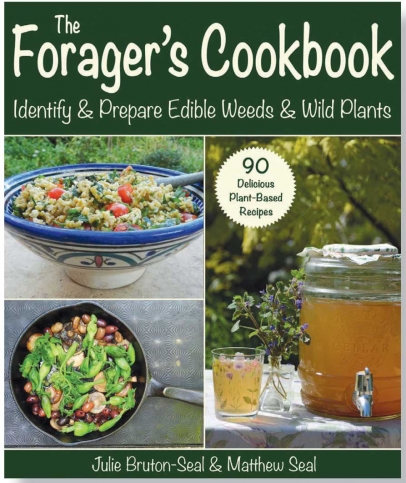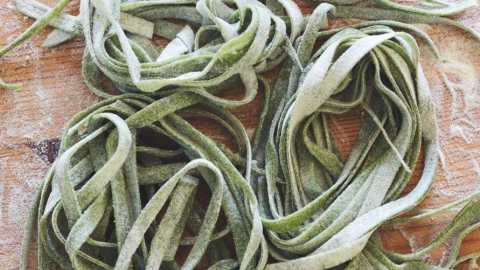The Forager's Cookbook
REVIEW BY MARIA BUTEUX READE
Identify & Prepare Edible Weeds and Wild Plants
Written by Julie Bruton-Seal and Matthew Seal
Photographs by Julie Bruton-Seal
Published by Skyhorse Publishing, 2023
If you’re a gardener or farmer, you inevitably view weeds as the enemy: pervasive nuisances that battle for crucial terrain in garden beds and fields. However, this book—simultaneously field guide, botanical history and cookbook—may cultivate a new appreciation for these wild plants by offering recipes that incorporate them into delicious, nutritious dishes and drinks.
Chickweed hummus. Dandelion flower syrup. Emerald-green nettle and pea soup. Ground ivy (aka Creeping Charlie) kombucha. Elderberry vinegar. Lamb’s-quarter saag aloo (greens cooked with potatoes and Indian spices). Mugwort and mushroom soup.
The authors wryly note, “If you are stuck with these tenacious life forms, perhaps it’s time to appreciate their good side. If you can’t beat them, eat them!” Once a gardener changes her mindset, a former nemesis becomes lunch.
Spring nettle leaves can be carefully harvested (wear protective gloves to avoid the sting, or cut with scissors directly into a bag or basket), blanched and pureed, then frozen into an ice cube tray. Pop a couple of intensely emerald-hued cubes into a blender with a banana, orange and apple juice, and you’ll have a superfood smoothie. The book also has a tempting recipe for a nettle cake, its beautiful pale-green layers sandwiched by lemony frosting.
Patches of garlic mustard at the edge of your yard? Boil and drain some potatoes, add a handful of the chopped leaves, then mash the mixture with milk or cream.
Is your shady garden bed overrun by ground elder, or bishop’s weed? Throw a cup or two of the chopped leaves into your quiche or frittata fillings.
Dandelions carpeting the lawn? Toss blanched dandelion greens with garlic, ginger, toasted sesame oil and soy sauce, and stir with sautéed mushrooms into a bowl of cooked noodles.
Julie Bruton-Seal and Matthew Seal admire weeds for their resilience as well as their taste and nutrition. In fact, many weeds are nutritional powerhouses, oftentimes with more minerals and vita-mins—not to mention stronger flavors—than standard commercial vegetables. Moreover, weeds frequently thrive in the shoulder seasons of late fall and early spring when other produce is waning or waxing. “Stick with these wild tastes,” they advise, “because you’re taking in the plant’s wildness, its survival strength.”
The British couple are longtime gardeners, naturalists, cooks and writers; this is their sixth book. Each chapter focuses on a different common weed—23 in all—and provides an in-depth history of the plant along with helpful advice on uses, gathering and cooking. As you turn the pages and read about readily recognizable foes, you begin to see them with fresh eyes and realize their new potential as free ingredients. The plant-based recipes draw from global cuisines and present a diverse array of savory and sweet main dishes, snacks and drinks. Julie’s close-up photographs reveal each plant’s innate beauty and assist with proper identification.
Readers are encouraged to learn to identify weeds common to our habitats. If you’re unsure of your identification skills or overwhelmed by the sheer range of weeds, see if there’s an herbalist, gardener or forager in your area who might take a plant walk with you (and be sure to off er all the free plant bounty in exchange for services!). Much like learning to identify mushrooms, a guided walk helps you to learn to see and properly identify nature’s edibles.
The book is replete with intriguing history with facts and anecdotes dating back centuries. Suggestions for herbal uses and cooking advice serve as compelling reasons to harvest rather than eradicate the weeds. For example, nettle leaves provide anti-inflammatory benefits, and gentle cooking removes the plant’s sting. Dried mugwort leaves add aromatic depth to rice, beans and tofu. All parts of the garlic mustard plant are edible: Leaves can be eaten raw or cooked, flower buds can be treated like broccoli, the tender stalks make a tasty snack or can be prepared as asparagus, the thick white root can be grated like horseradish. Ground ivy, or Creeping Charlie, makes a lovely cleansing tea or can be used as a soup stock; finely chopped leaves find a natural home in buttery shortbread and scones. Lamb’s-quarter leaves are loaded with vitamins A and C, retain their bright color when cooked and can be used as spinach or other mild greens.
Perusing this book may change your view of weeds and off er delicious ways to make peace with Mother Nature’s abundant, free resource.
The following three recipes and photographs from The Forager’s Kitchen, © 2023 by Julie Bruton-Seal and Matthew Seal are reprinted with permission from Skyhorse Publishing.









